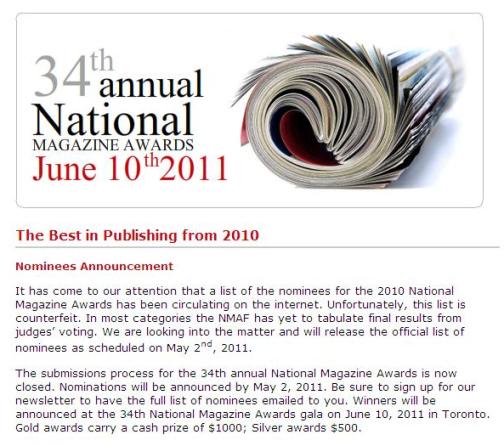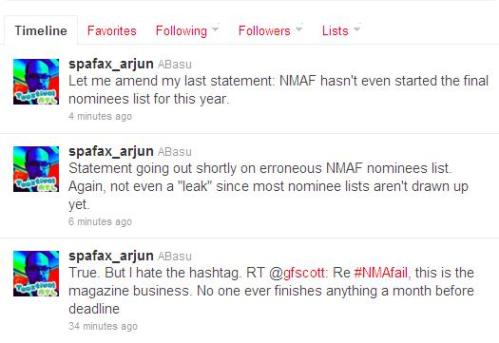NMA SOS?
An embarrassing public reveal of a list of nominees, a month ahead of schedule, and complaints from a National Magazine Award judge about problems with the judging process, suggest that all is not well with the annual literary awards.
On April 6, word spread quickly around Twitter that a list of this year’s NMA nomimees was out. Since the announcement wasn’t due until May, this came as a surprise to many, especially the writers who found their work amongst the nominees. Soon after, though, a statement was posted on the National Magazine Award Foundation site (above) that called the list “counterfeit.”
The snafu had some asking right away, though, whether the leak was a malicious ruse by someone outside the NMAF or if it was, as seemed far more likely, a mistake.
Arjun Basu, the president of the National Magazine Awards Foundation, reacted quickly to the situation, responding to inquiries on Twitter and pointing people to the NMAF website for updates. In response to Story Board‘s question early in the afternoon on April 6 about whether NMA would offer an explanation about where the list came from, Basu said: “We’re investigating what happened now. Once we understand the circumstances, we will let people know. Stay tuned.”
But then the full “counterfeit” list was posted on Torontoist. After seeing the length and breadth of the list, many were convinced it was the real thing, even if it was to go through another round of judging.
By 5 p.m. the same day, a lengthy explanation was posted on NMA’s front page that began: “How did this morning’s inaccurate nominee list get created and released? The NMAF and our web developers have spent the day figuring this out, and here’s what appears to have happened.”
What follows is a very detailed account of a technical glitch that resulted in the (not yet whittled down) list of this year’s nominees going live. Despite its initial claims that the list was “counterfeit,” NMAF did well by owning up to the mistake and describing exactly what went wrong. For an organization that’s on the radar of many journalists across the country, transparency is really the only option.
We asked writer Ryan Bigge, whose piece “The Wheat of Sadness” appeared on the list in the Arts & Entertainment category how he felt about the list being revealed. Bigge seemed to take the error in stride: “It’s obviously a strange feeling to be incorrectly (or, hopefully, prematurely) nominated, but I’ll survive,” he wrote. “It’s not as though I’m Al Gore being told his presidency has been declared void.”
We also spoke with a judge involved in this year’s NMA selection process, who was concerned about problems with the way pieces are submitted and judged. The judge, who wished to remain anonymous, told us that the NMA categories are not sufficiently defined, and this negatively impacts the entire process. After reading dozens of entries, the judge was dismayed to see the broad range of work that had all been submitted to the same category. “It became really obvious, looking through the entries, that there was such a wide idea of what the category meant—what kind of article you should be submitting to it—that I got really confused about what the category was,” said the judge. “”The categories are kind of complicated and not very well explained.”
On a conference call with other judges, before scores were submitted, it became clear that each judge had approached the challenge differently, and some judges gave more or less weight to how well the piece fit the category, as opposed to judging based on its quality alone. The NMAF representative taking part in the conference call did not offer any guidance.
Further, the judge told us that pieces can be disqualified based on not fitting the category, but when this happens the person who submitted it, and paid the $75 fee, is not told their work was not thoroughly considered. As a result, there could be writers who submit pieces again and again each year that are of high quality but do not fit the category. “So maybe the pieces that I submitted or my magazine submitted, they just never even made it,” said the judge.
If this problem arises in numerous categories (we’ve heard this same sentiment echoed from others who’ve submitted work), it means that there is good work being thrown out of the running for NMAs each year. For everyone’s sake, it’s time for NMAF to start providing both entrants and judges with detailed, objectively defined descriptions of each category. Until they do, the NMA process will continue to be an exercise in frustration for everyone involved.





